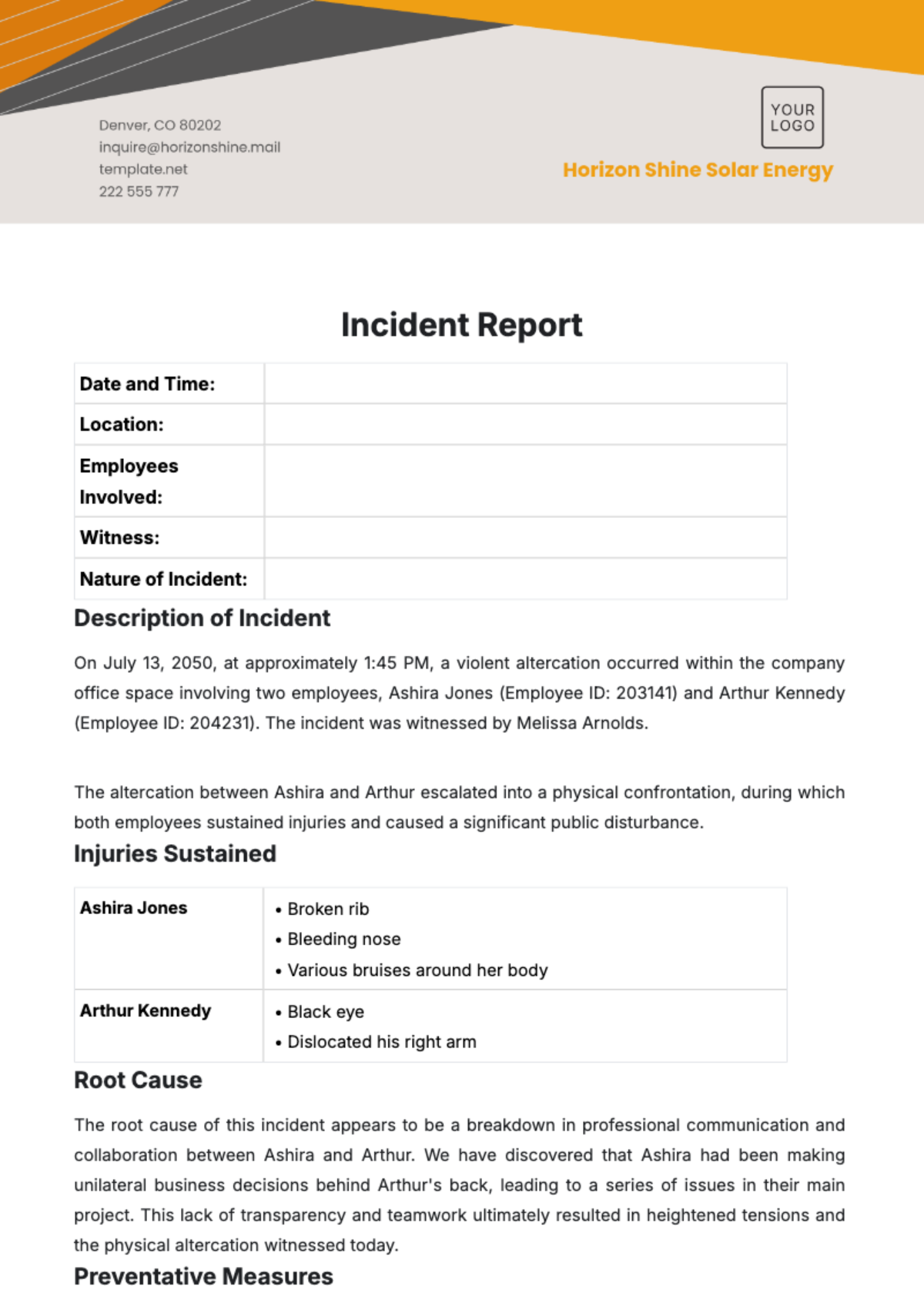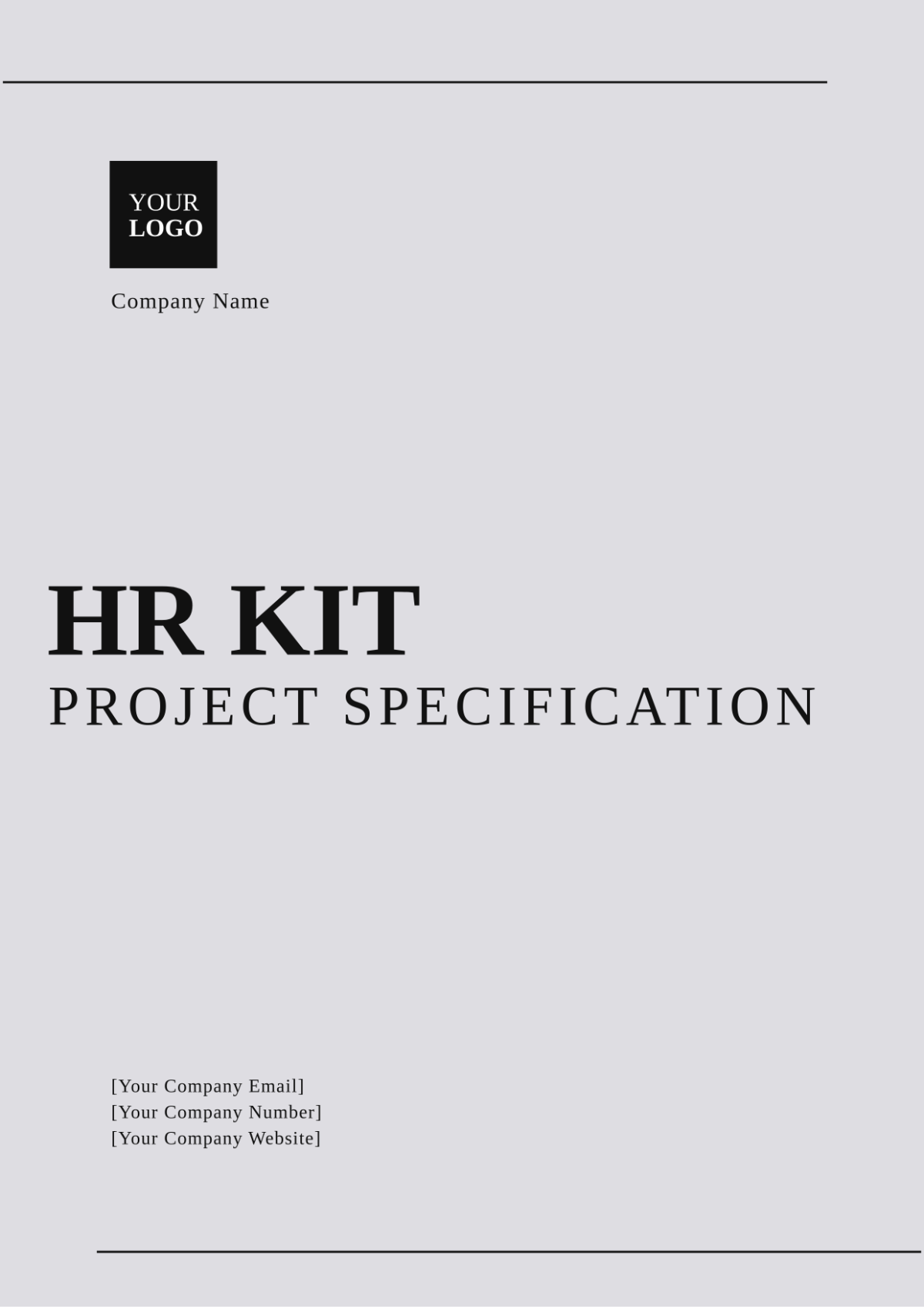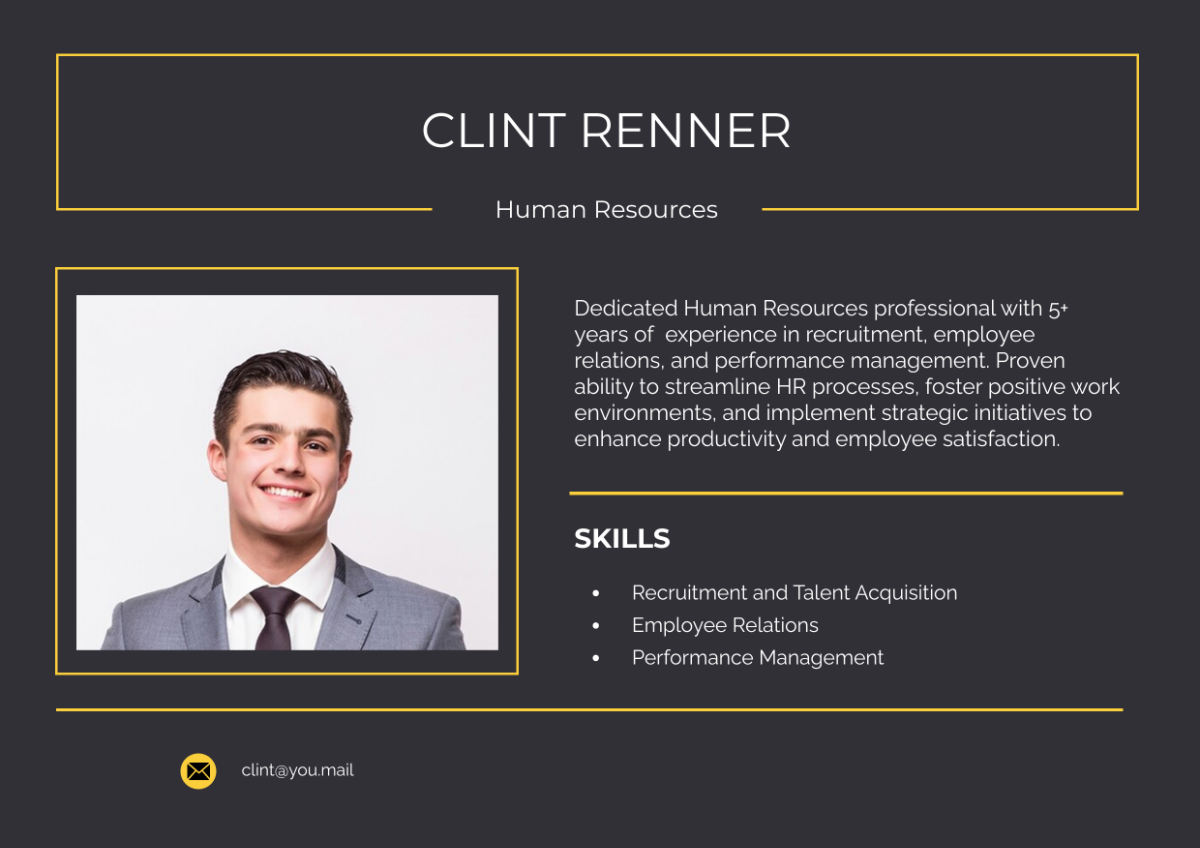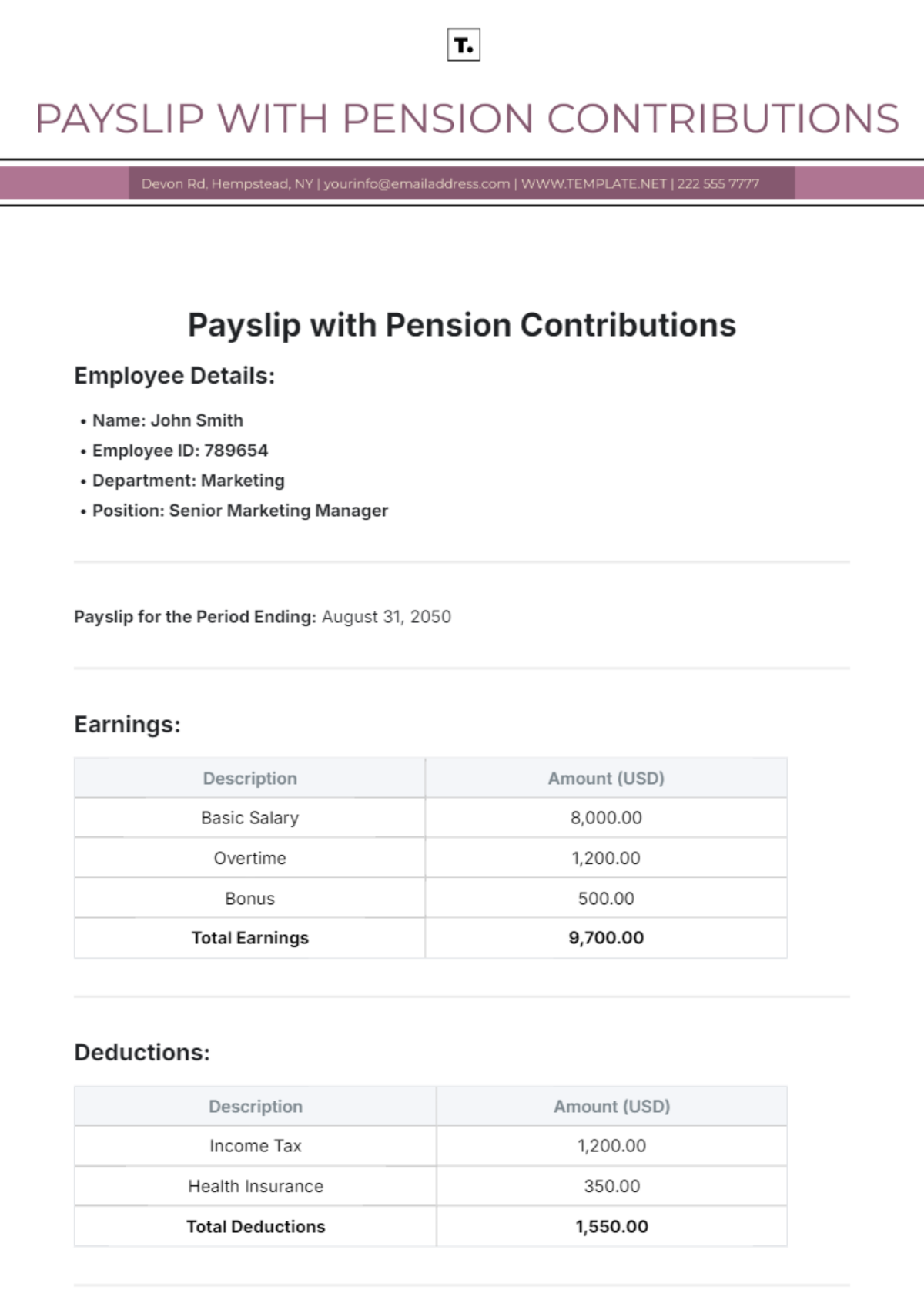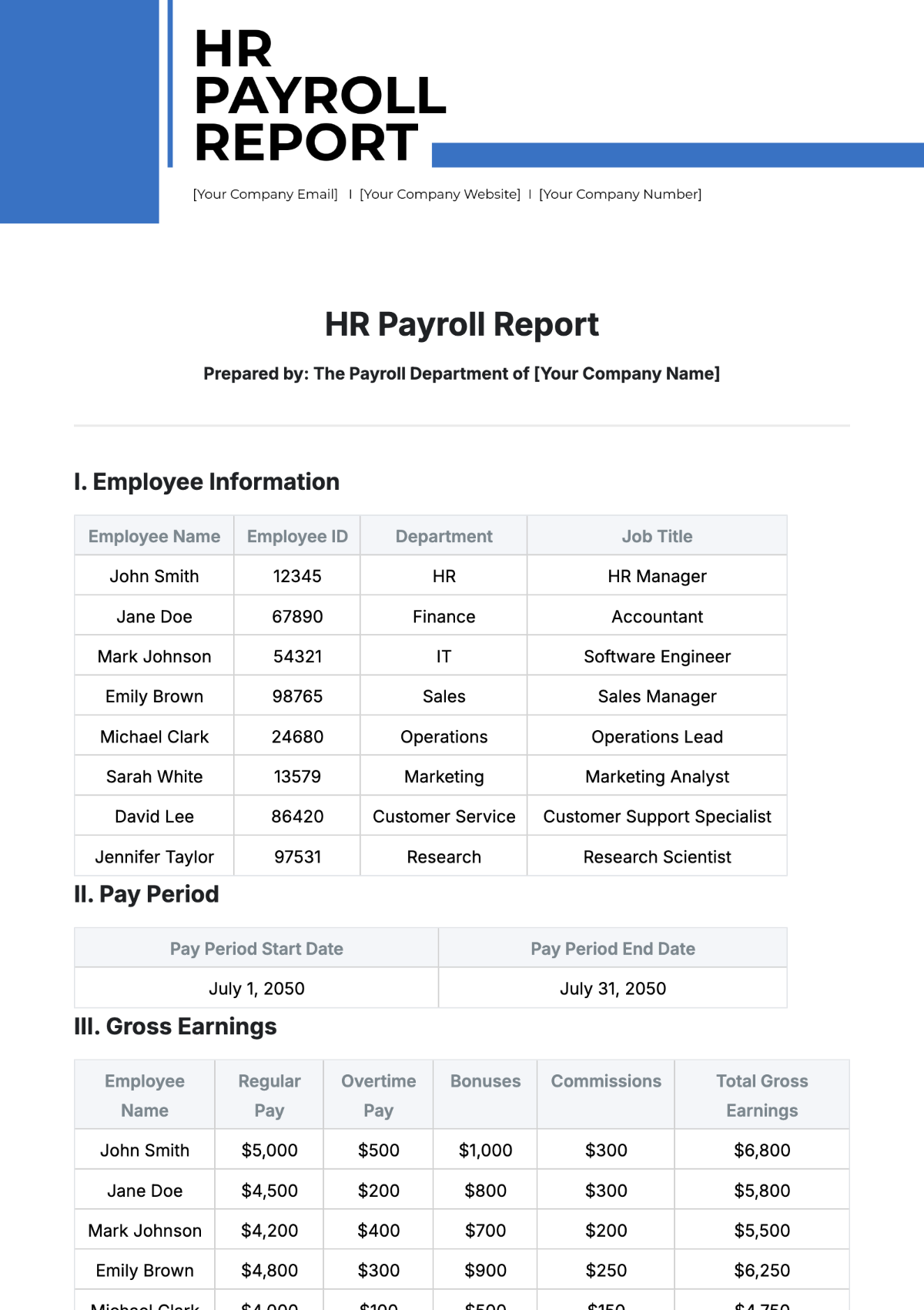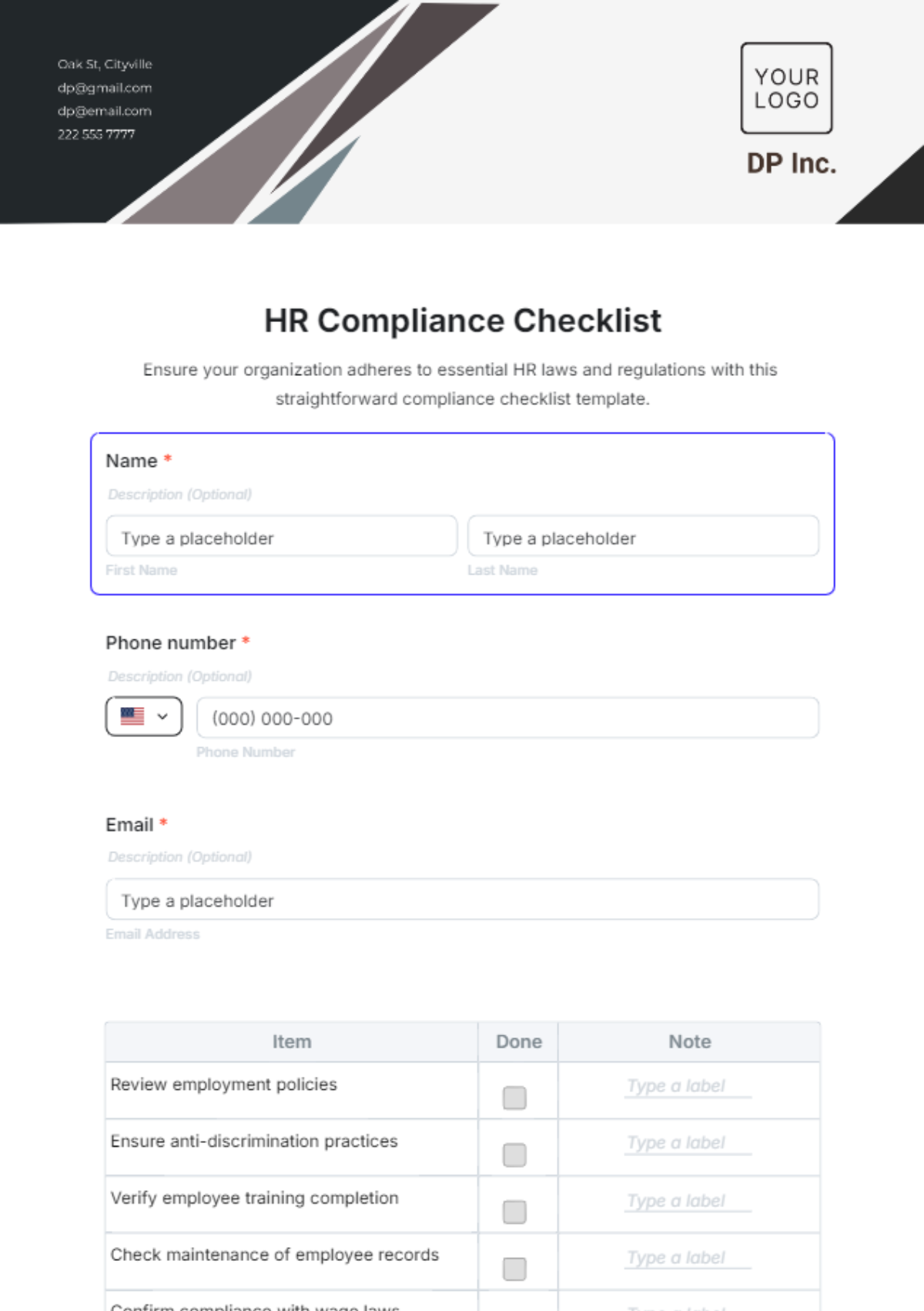Workplace Safety and Health Protocol
Table of Contents
1. Introduction........................................................................................................2
2. Objectives..........................................................................................................2
3. Scope.................................................................................................................3
4. Roles and Responsibilities.................................................................................4
5. Safety Measures................................................................................................5
6. Emergency Procedures.....................................................................................6
7. Training Programs..............................................................................................6
8. Reporting and Record-Keeping.........................................................................7
9. Compliance........................................................................................................8
10. Review and Amendments................................................................................8
11. Appendices.......................................................................................................9
1. Introduction
In today's dynamic work environment, maintaining a safe and healthy workspace is not just a legal obligation but also a crucial element for the overall success of the organization. At [Company Name], we deeply value the health and safety of our employees, contractors, visitors, and other stakeholders who interact with our organizational setting. With that understanding, we have developed this Workplace Safety and Health Protocol Manual to serve as a one-stop resource for understanding the comprehensive safety standards, guidelines, and procedures that we adhere to.
Our primary aim is to minimize occupational risks and create an environment where safety and well-being are not afterthoughts but are ingrained in our organizational culture. The manual covers a broad range of topics from emergency response plans, mental well-being initiatives, to physical safety measures, and is intended for everyone — from new hires to senior management. We expect all individuals to familiarize themselves with the contents of this manual and to apply these guidelines in their daily activities.
By aligning our safety and health protocols with national and international standards, we are committed to continuous improvement in our practices. Please read the manual carefully, as compliance is mandatory and essential for maintaining a safe and healthy workplace for everyone. Thank you for being a valuable part of [Company Name], and for your commitment to fostering a culture of safety and health.
2. Objectives
The primary objective of this Workplace Safety and Health Protocol Manual is far-reaching and holistic. At its core, it aims to establish a secure and health-conscious work environment for all employees, contractors, visitors, and stakeholders involved with [Company Name]. We endeavor to minimize, if not entirely eliminate, the risks and vulnerabilities associated with occupational hazards. To achieve this, the manual outlines various protocols, practices, and emergency procedures aimed at enhancing individual and collective safety.
Another critical aim is to ensure strict compliance with all applicable local, state, and federal laws and regulations concerning workplace safety and health. We strive to go beyond mere legal obligations by implementing best practices and continually updating our safety protocols to meet or exceed industry standards.
Additionally, this manual serves as an educational tool, fostering a culture of safety and health by informing all personnel about their responsibilities and the guidelines they are expected to follow. We believe that informed employees are empowered employees, capable of making responsible choices that benefit not just themselves but the entire organization.
Through these objectives, we commit to creating a workplace where safety and health are not just policies but a way of life. Adherence to the guidelines in this manual is crucial for achieving these objectives and for the continued success and well-being of everyone connected to [Company Name].
3. Scope
The scope of this Workplace Safety and Health Protocol Manual is comprehensive, covering all individuals who have a professional interaction with [Company Name]. This includes full-time and part-time employees, contractors, freelancers, interns, visitors, and any other stakeholders who may be present at any of our locations or engaged in any activities related to our organization.
This manual is intended to be a one-stop resource for understanding the policies and practices related to safety and health within our organization. It includes a wide range of guidelines, from general safety procedures to specialized protocols for specific job functions or departments. These guidelines encompass everyday occupational scenarios as well as emergency situations, thereby aiming to provide well-rounded strategies for a myriad of circumstances that could impact workplace safety and health.
Whether you work in an office, remote location, or field setting related to [Company Name], this manual has been designed to be applicable and useful. It covers topics such as general safety measures, first aid procedures, emergency evacuation plans, and proper use of safety equipment, among others. It also addresses various types of risks including, but not limited to, physical hazards, chemical exposures, ergonomic concerns, and psychosocial factors like workplace harassment.
By implementing these guidelines, [Company Name] aims to foster a proactive safety culture where the well-being of each individual is a shared responsibility. Adherence to the guidelines in this manual is mandatory for all, and non-compliance may result in disciplinary actions as specified in later sections of this document.
4. Roles and Responsibilities
The success of any workplace safety and health initiative is a collective endeavor that requires the engagement and responsibility of everyone in the organization. This chapter aims to clarify the roles and responsibilities of different stakeholders in [Company Name] concerning the implementation and adherence to the guidelines outlined in this manual. By understanding and fulfilling these roles, we can collaboratively create a safer and healthier working environment for all.
● Management: The management team holds the ultimate responsibility for the establishment, execution, and maintenance of all health and safety protocols within [Company Name]. This includes ensuring that the workplace complies with local, state, and federal safety and health regulations. Management is also responsible for securing adequate resources to implement these measures effectively. This encompasses, but is not limited to, making certain that safety equipment is available and functional, emergency exits and routes are clearly marked, and that hazardous areas are identified and controlled.
● HR Department: The Human Resources Department serves as the primary liaison between management and employees when it comes to workplace safety and health. They are tasked with the dissemination of this manual to all employees and ensuring that staff is adequately trained on the guidelines within it. The HR department is also responsible for updating the manual as necessary and organizing regular safety drills. They will be the point of contact for any safety-related concerns, grievances, or suggestions from employees.
● Employees: Employees are the backbone of [Company Name] and are essential participants in upholding safety and health standards. All employees, irrespective of their roles or job functions, are required to adhere strictly to the safety guidelines and procedures outlined in this manual. Compliance is not optional; failure to abide by these rules can jeopardize not only the individual's safety but also that of colleagues and visitors. Employees are also encouraged to report any safety hazards or concerns immediately to their supervisors or the HR department. This will facilitate prompt action and helps foster a culture of shared responsibility for safety and well-being within the workplace.
5. Safety Measures
Safety in the workplace is a multifaceted concept that extends beyond the physical environment. It also encompasses the mental well-being of our staff, as well as emergency preparedness. This chapter is designed to outline the various safety measures [Company Name] has put in place to protect its most valuable asset—its employees. To make the information easily accessible, we have organized the measures into a comprehensive table form that covers different aspects of workplace safety.
Section | Safety Measures | Description |
5.1 Physical Safety | Preventative Measures | Includes ergonomic assessments, provision of PPE (Personal Protective Equipment), and regular safety audits to ensure a physically safe work environment. |
5.2 Mental Health | Employee Assistance Programs | Offers employee assistance programs that provide confidential counseling services. |
| Stress Management Sessions | Periodic stress management sessions and workshops are held to help employees manage work-related stress effectively. |
| Open-Door Policies | Maintains open-door policies that allow employees to discuss mental well-being without fear of judgment. |
5.3 First Aid | Availability of First Aid Kits | First aid kits are placed strategically around the workplace for easy access during emergencies. |
| First Aid Training | Select employees are trained in basic first aid procedures, equipping them to assist during minor medical emergencies. |
By following these safety measures diligently, we strive to create a safer, healthier, and more productive work environment for everyone involved.
6. Emergency Procedures
Ensuring the safety of our employees during emergencies is of paramount importance to [Company Name]. Our comprehensive emergency procedures are meticulously planned to cover various types of incidents, including but not limited to fires, natural disasters, and other unforeseen events. Fire drills are conducted on a regular basis to familiarize staff with evacuation processes and to test the efficiency of our emergency response. Clearly marked emergency exit routes are displayed throughout the premises, allowing for quick and organized evacuations. Additionally, we have designated points of contact for different types of emergencies. These individuals are trained to manage crisis situations and are the go-to persons for coordinating immediate actions. By preparing in advance and educating our employees on these procedures, we aim to mitigate the impact of any emergency situation and ensure the well-being of everyone in our premises.
7. Training Programs
At [Company Name], we place a strong emphasis on continuous learning and preparedness, especially when it comes to the safety and well-being of our employees. To this end, we conduct mandatory training programs that are designed to equip our staff with the knowledge and skills they need to maintain a safe and healthy working environment. These training sessions are held semi-annually and are crucial for new hires as well as for existing employees as a refresher.
The training curriculum is comprehensive and covers a range of vital topics. The first pillar focuses on general safety measures, including the correct usage of Personal Protective Equipment (PPE), ergonomics, and hazard identification. The second pillar is dedicated to emergency response training, which aims to prepare employees for various types of emergency situations, teaching them how to act swiftly and effectively. This includes fire safety, emergency evacuation procedures, and basic first-aid techniques.
Lastly, we also address workplace harassment in our training modules. These sessions are geared toward fostering a respectful and inclusive workplace, and they cover the policies, reporting mechanisms, and legal implications related to harassment.
Overall, the objective of these training programs is not just compliance with laws and regulations but also the cultivation of a culture that values the safety, health, and dignity of every individual in the organization.
8. Reporting and Record-Keeping
Effective reporting and meticulous record-keeping are vital components of [Company Name]'s workplace safety and health protocols. All employees are mandated to report any safety incidents, accidents, or hazardous conditions immediately to their respective supervisors or directly to the Human Resources Department. This prompt reporting is crucial for taking immediate corrective action and for preventing similar incidents in the future.
Upon receiving a report, the HR Department is responsible for conducting a thorough investigation to determine the cause of the incident and to recommend preventive measures. The department is also tasked with maintaining comprehensive records of all reported incidents, which are stored securely to ensure confidentiality. These records include but are not limited to incident reports, witness statements, photographs, and any other relevant documentation.
The purpose of this extensive record-keeping is multifold. First, it aids in the ongoing assessment and improvement of our safety protocols by providing data-driven insights. Second, these records are crucial for legal compliance and may be subject to audits by regulatory agencies. Third, in the unfortunate event of repeated incidents, these records serve as an evidentiary trail that can guide further actions, including but not limited to, potential changes in workplace procedures or disciplinary actions against individuals, if warranted.
By adhering to these reporting and record-keeping protocols, we aim to create an accountable, transparent, and safe work environment for all employees, contractors, and visitors.
9. Compliance
Adherence to the guidelines and procedures outlined in this Workplace Safety and Health Protocol Manual is not optional; it is a mandatory requirement for all employees, contractors, and visitors at [Company Name]. Failure to comply with these protocols compromises not only individual safety but also the well-being of colleagues and the broader work environment. Therefore, non-compliance will be considered a serious offense and may result in disciplinary action, up to and including termination of employment.
The range of disciplinary actions can vary depending on the severity and frequency of the violation. Minor offenses may start with verbal or written warnings and mandatory re-training on the protocols. Repeated or serious violations, such as knowingly putting another person at risk or failing to report a safety hazard, could lead to suspension, demotion, or even termination. In extreme cases, legal action may also be pursued.
It is the responsibility of the HR Department to ensure that all disciplinary actions are fair, consistent, and well-documented to uphold the integrity of [Company Name]'s commitment to safety and health. Management will also periodically review compliance levels and may make amendments to this manual to improve its effectiveness. By strictly adhering to these protocols, we aim to foster a culture that prioritizes safety and health for everyone associated with [Company Name].
10. Review and Amendments
The dynamic nature of workplace safety and health considerations necessitates a living document that can adapt to new challenges, regulations, and best practices. Therefore, this Workplace Safety and Health Protocol Manual will undergo an annual review by a dedicated committee comprising representatives from the Management and HR Department of [Company Name]. The review will take into account any incidents, compliance issues, or changes in local or federal regulations. Furthermore, feedback from employees will be actively sought to ensure the manual remains both practical and effective. Following the review, amendments will be made as necessary to keep the manual current and compliant with both legal requirements and industry standards. All updates will be communicated to staff in a timely manner, and additional training sessions may be scheduled as required to ensure everyone is familiar with any new procedures or guidelines.
11. Appendices
Sample Incident Report Form
[Company Name] Incident Report Form
Date of Incident:
_____________________________________________________________
Time of Incident:
_____________________________________________________________
Location:
____________________________________________________________
Name of Employee Involved:
_____________________________________________________________
Job Position:
_____________________________________________________________
Description of Incident:
_____________________________________________________________
Names of Witnesses:
____________________________________________________________
Immediate Actions Taken:
_____________________________________________________________
Reported to (Name & Job Position):
_____________________________________________________________
Signature:
_____________________________________________________________
Safety Audit Checklist
[Company Name] Safety Audit Checklist
Date of Audit: ______________________________________________
Auditor's Name: ______________________________________________
Area Audited: ______________________________________________
Items | Compliant (Y/N) | Remarks |
Fire Extinguishers |
|
|
First Aid Kits |
|
|
Emergency Exit Signs |
|
|
PPE Availability |
|
|
Electrical Safety |
|
|
Emergency Contact List
[Company Name] Emergency Contact List
Name | Job Position | Emergency Contact Number | |
[Names] | [Job Position] | [User Phone] | [Personal Email] |
[Names] | [Job Position] | [User Phone] | [Personal Email] |
[Names] | [Job Position] | [User Phone] | [Personal Email] |
For any additional information or clarification, please contact the HR department at [Company Email] or [Company Phone Number].
For any queries or clarifications, please contact:
[Names]
[Job Position]
[Personal Email]
[User Phone]
[Date]


